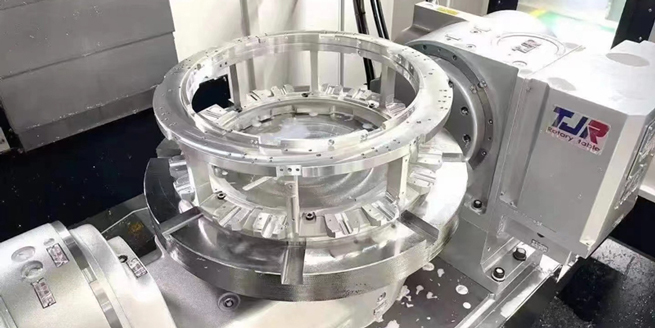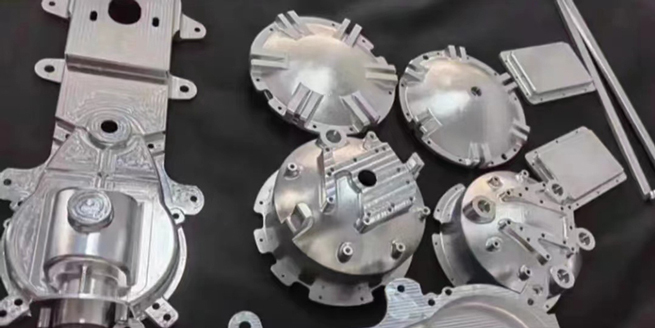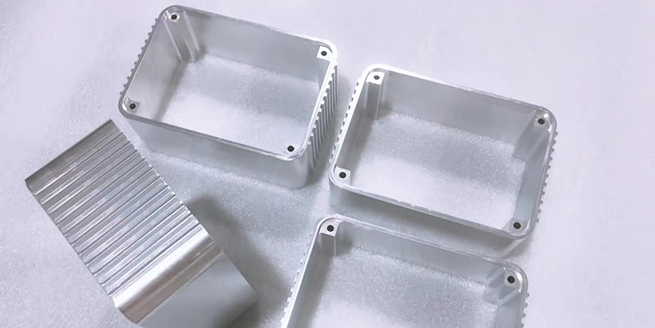Aluminum CNC machining is a precise and versatile manufacturing process that utilizes computer-controlled machines to shape and cut aluminum into various components. This method is widely favored across industries for its ability to produce intricate and high-precision parts with efficiency and consistency. The process involves subtractive techniques, where material is selectively removed from an aluminum workpiece to achieve the desired design and specifications. With applications ranging from aerospace to automotive and electronics, aluminum CNC machining offers a reliable solution for creating complex geometries and meeting the stringent demands of modern engineering and design.

Process:
Aluminum machining is a subtractive manufacturing process where material is selectively removed from an aluminum workpiece to achieve the desired shape and dimensions. This is commonly achieved through computer numerical control (CNC) machining, a precise method that uses automated tools to cut, shape, and finish aluminum components.
Methods:
Milling: In milling, rotary cutting tools remove material from a workpiece. CNC milling machines can create a wide range of shapes and features, making it a versatile method for aluminum machining.
Turning: Turning involves rotating a workpiece against a cutting tool, creating cylindrical shapes. CNC turning is effective for producing axially symmetric parts.
Drilling: Drilling creates holes in the aluminum using drill bits. CNC drilling ensures accuracy and consistency in hole placement and dimensions.
EDM (Electrical Discharge Machining): In EDM, electrical discharges erode the aluminum to shape it. This method is suitable for intricate and delicate work.
Features:
Precision: Aluminum machining offers high precision, allowing for tight tolerances and intricate details in the final product.
Versatility: The process is versatile, accommodating a wide range of part sizes, complexities, and geometries, making it suitable for various applications.
Efficiency: CNC machining automates the process, leading to efficient and consistent production with minimal human error.
Material Removal: The ability to selectively remove material enables the creation of complex shapes and lightweight components.
Surface Finishes: Machined aluminum parts can undergo various surface finishes such as anodizing, polishing, or powder coating, enhancing both functionality and aesthetics.

Aluminum alloys come in various grades, each offering distinct properties that cater to specific applications. Understanding these grades is essential for selecting the most suitable alloy for a given project. Here are some common types:
Alloy 1100:
Properties: Excellent corrosion resistance and high thermal conductivity.
Applications: Typically used in applications requiring low strength but high formability, such as food containers and architectural components.
Alloy 2011:
Properties: Good machinability, fair corrosion resistance.
Applications: Commonly used for screws, bolts, and other high-speed machining applications.
Alloy 3003:
Properties: Good formability, moderate strength, and excellent corrosion resistance.
Applications: Widely used in kitchenware, storage tanks, and general sheet metal work.
Alloy 6061:
Properties: Good mechanical properties, weldability, and high resistance to corrosion.
Applications: Commonly used in structural components, automotive parts, and marine applications.
Alloy 6063:
Properties: Good extrudability, heat treatable, and corrosion resistance.
Applications: Frequently used in architectural and decorative applications, as well as in electrical conduits.
Alloy 7075:
Properties: High strength, excellent strength-to-weight ratio.
Applications: Ideal for aerospace applications, including aircraft structures and high-stress components.
Alloy 5052:
Properties: Good corrosion resistance, high fatigue strength.
Applications: Commonly used in marine applications, transportation equipment, and chemical processing.
Alloy 5083:
Properties: Excellent corrosion resistance, good weldability.
Applications: Primarily used in naval applications, such as shipbuilding.
Alloy 2024:
Properties: High strength, excellent fatigue resistance.
Applications: Frequently used in aerospace applications, including aircraft structures.
Achieving the desired surface finish on machined aluminum parts is crucial for both functional and aesthetic purposes. Different surface finishes offer various benefits, enhancing properties such as corrosion resistance, durability, and visual appeal. Here are common surface finishes for machined aluminum parts:
Anodizing:
Process: An electrochemical process that forms an oxide layer on the aluminum surface.
Benefits: Improves corrosion resistance, hardness, and provides a decorative finish. Different colors are achievable.
Polishing:
Process: Mechanical polishing involves abrasives to create a smooth, reflective surface.
Benefits: Enhances appearance, removes imperfections, and improves corrosion resistance. Mirror finishes are possible.
Brushed Finish:
Process: Achieved by brushing the aluminum surface with abrasive material.
Benefits: Creates a textured appearance, hides scratches, and provides a matte finish.
Powder Coating:
Process: A dry finishing process where a powdered coating is applied electrostatically and then cured.
Benefits: Offers a durable, uniform finish in various colors. Provides excellent corrosion resistance.
Chemical Film Coating (Chromate Conversion Coating):
Process: A chemical process that forms a protective film on the aluminum surface.
Benefits: Improves corrosion resistance and electrical conductivity. Can be clear or yellowish.
Bead Blasting:
Process: Involves propelling fine glass beads at high pressure to clean and finish the surface.
Benefits: Creates a uniform matte finish, removes tool marks, and enhances surface texture.
Electropolishing:
Process: Electrochemical process that removes a thin layer of material to improve surface smoothness.
Benefits: Creates a bright, reflective surface, improves corrosion resistance, and reduces microscopic surface flaws.

Selecting the right CNC machined aluminum parts involves considering factors such as:
Material Grade: Choosing an alloy that aligns with the application's demands.
Dimensional Precision: Ensuring the parts meet specific size and tolerance requirements.
Surface Finish: Selecting a finish that enhances functionality and appearance.
Collaborating with experienced manufacturers like Falcon MFG ensures the production of tailored aluminum components that meet industry-specific needs.
The choice between 6061 and 7075 aluminum depends on project requirements. 6061 is known for good weldability and moderate strength, while 7075 offers high strength and stress resistance. The decision is influenced by factors such as load-bearing requirements and environmental conditions.
Falcon MFG specializes in custom CNC aluminum machining, leveraging advanced technology and a skilled workforce. With a commitment to precision, quality, and client satisfaction, Falcon MFG ensures the production of high-performance and reliable aluminum components tailored to the unique needs of diverse industries. Their expertise spans aerospace, automotive, electronics, and more.